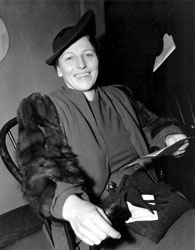Pearl Buck is best known for her novel “The Good Earth,” which received the Pulitzer Prize in 1935 and helped earn her the Nobel Prize in Literature in 1938.
Buck was the first American woman to win the Nobel Prize. Throughout her life, she published more than 70 books in various genres, including children’s literature and poetry.
Born on June 26, 1892, in Hillsboro, West Virginia, Buck was the daughter of Southern Presbyterian missionaries, and most of her childhood was spent in Chinkiang in China’s Kiangsu province. She graduated from Randolph-Macon Woman’s College in Virginia in 1914, and three years later, married agricultural economist John Lossing Buck. The couple settled in the rural Chinese province of Anhwei, which served as inspiration for much of Pearl’s writing.
The marriage was said to have been unhappy, and Buck would later become an outspoken feminist, telling interviewer Mike Wallace in February 1958, “I don’t like in general, for the sake of men, to have it said that the approach is through the stomach or even solely through the heart.”
Sources in this Story
- University of Pennsylvania English Department: Pearl Sydenstricker Buck, 1892-1973
- The University of Texas at Austin: Harry Ransom Center: The Mike Wallace Interview: Pearl Buck
- The University of Texas at Austin: Harry Ransom Center: The Mike Wallace Interview:
Nobel Prize Winners - Nobel Foundation: Pearl Buck: The Nobel Prize in Literature 1938
She eventually divorced her first husband and married Richard Walsh, with whom she adopted six children. The couple settled in Pennsylvania and became involved in civil rights and humanitarian organizations.
Buck was also a noted women’s rights advocate, telling Wallace, “Women can fulfill all the obligations and joys of home and at the same time be citizens of their nation and of the world.” She was featured in an interview filmed during the American Nobel Anniversary Committee Dinner in New York in January 1958. She died March 6, 1973.
For a complete biography, visit Pearl Buck’s page on the Nobel Foundation Web site.
This article was originally written by Sarah Amandolare; it was updated May 24, 2017.











